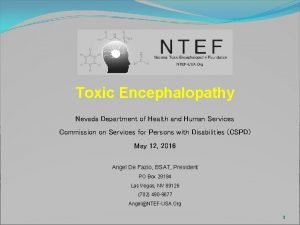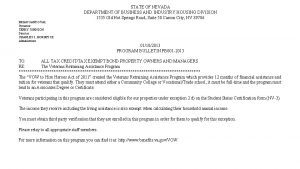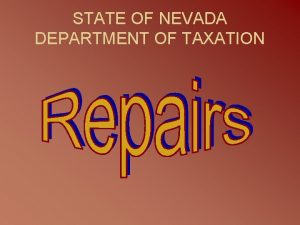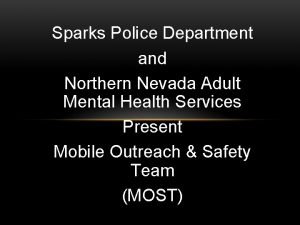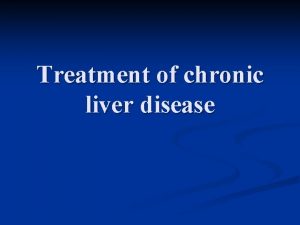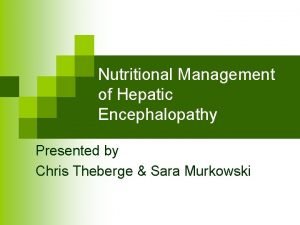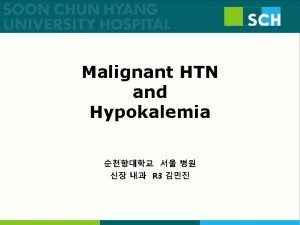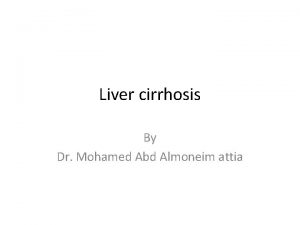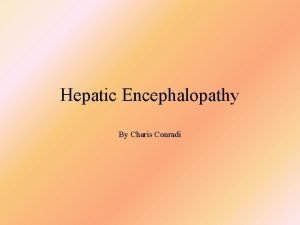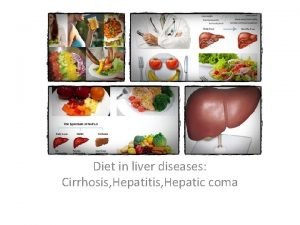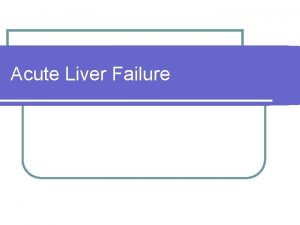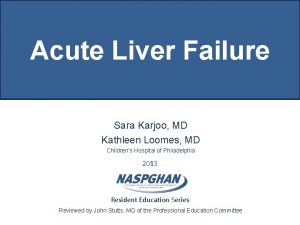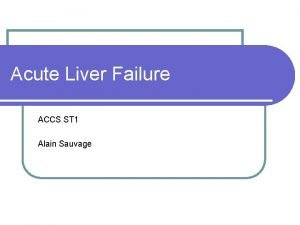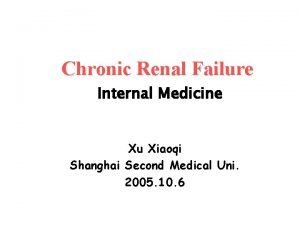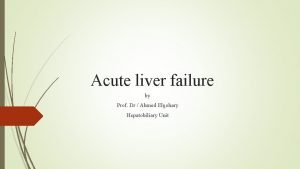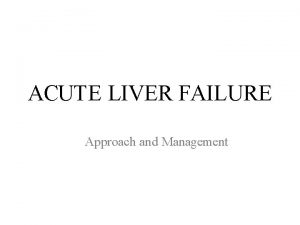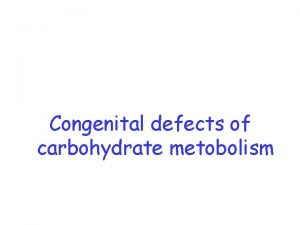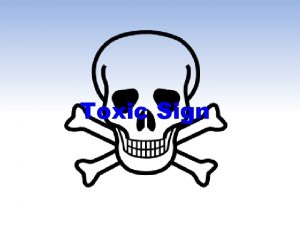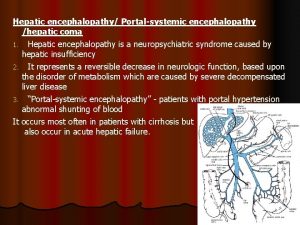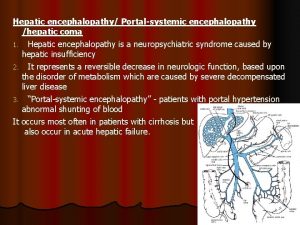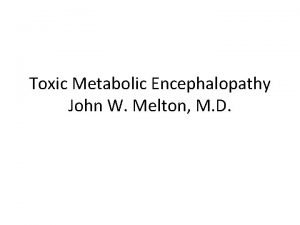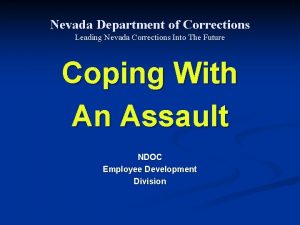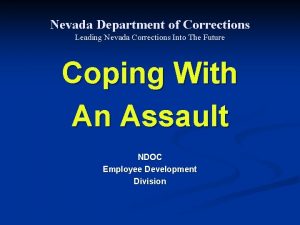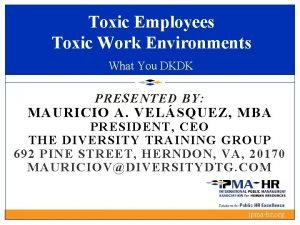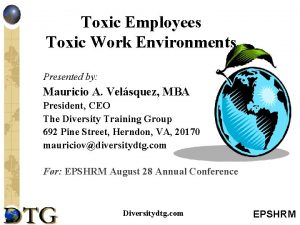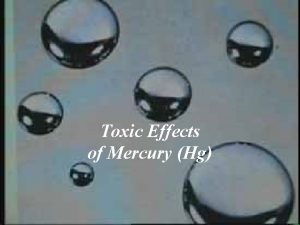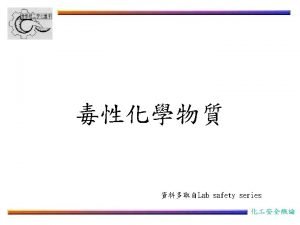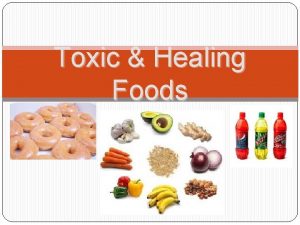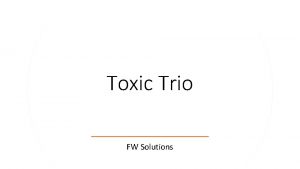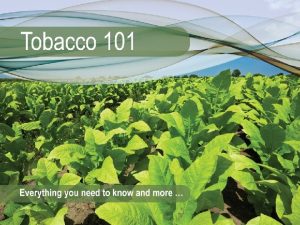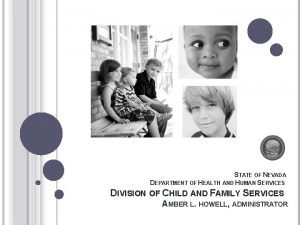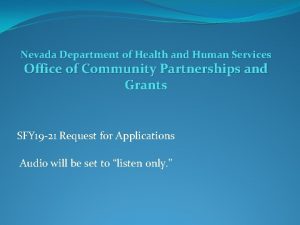Toxic Encephalopathy Nevada Department of Health and Human



























- Slides: 27

Toxic Encephalopathy Nevada Department of Health and Human Services Commission on Services for Persons with Disabilities (CSPD) May 12, 2016 Angel De Fazio, BSAT, President PO Box 29194 Las Vegas, NV 89126 (702) 490 -9677 Angel@NTEF-USA. Org 1

Overview 1/2 • Definition • Types • Causation • Same Causation-Different Name • Signs/Symptoms • Prevalence • Diagnosis • Treatment/Prognosis • Barriers • Accommodating Benefits Everyone 2

Overview 2/2 • Centers for Disease Control • U. S. Department of Health & Human Services • U. S. Census Bureau • U. S. Department of Justice • U. S. Access Board • American Lung Association 3

What is Encephalopathy? National Institute of Neurological Disorders and Stroke, a division of the National Institutes of Health, definition: • Disease of the brain that alters brain function or structure • Infectious agent (bacteria, virus or prion) • Metabolic or mitochondrial dysfunction • Brain tumor or increased pressure in the skull • Prolonged exposure to toxic elements (including solvents, drugs, radiation, paints, industrial chemicals and certain metals) • Chronic progressive trauma • Poor nutrition • Lack of oxygen or blood flow to the brain 4

What is Neuro-toxicity? • Exposure to natural or manmade toxic substances (neurotoxicants) alters the normal activity of the nervous system • Disrupts or even kills neurons---key cells that transmit and process signals in the brain and other parts of the nervous system • Exposure to substances used in chemotherapy, radiation treatment, drug therapies, and organ transplants • Heavy metals such as lead and mercury • Certain foods and food additives • Pesticides • Industrial and/or cleaning solvents • Cosmetics and artificial or man-made fragrances • Some naturally occurring substances • Symptoms may appear immediately or be delayed 5

Types of Encephalopathy 1/2 Chronic traumatic- multiple traumas or injuries to the brain Encephalomyopathy- A combination of encephalopathy and myopathy (skeletal muscles, cell structure and metabolism) Glycine- a genetic condition, high levels of glycine (an amino acid) Hashimoto’s- a rare effect autoimmune disease, attacks the thyroid gland Hepatic- liver disease Hypertensive- very high blood pressure Hypoxic ischemic- not enough oxygen Infectious- Infections from bacteria, viruses, and fungi, inflammation of the brain tissue or of the meninges (meningitis) Lyme- Lyme disease Mitochondrial- dysfunction of mitochondrial DNA 6

Types of Encephalopathy 2/2 Neonatal- An obstetric form; lack of oxygen in blood flow to brain tissue of the fetus during labor or delivery Salmonella- food poisoning (especially out of peanuts and rotten meat) permanent brain damage and nervous system disorders Static- lack of oxygen Structural- Head trauma Toxic- chemicals, often resulting in permanent brain damage Toxic metabolic- infections, toxins, or organ failure, abnormalities of the water, electrolytes, vitamins, and other chemicals Transmissible spongiform- prion diseases, kuru, and Creutzfeldt. Jakob Uremic- kidney failure Wernicke- vitamin B 1 deficiency 7

ICD Codes 2016 ICD-10 -CM Diagnosis Code G 92 Toxic encephalitis Toxic metabolic encephalopathy Approximate Synonyms: Encephalopathy, toxic Inflammation of brain and spinal cord due to toxic substance Inflammation of spinal cord due to toxin Toxic encephalitis, toxin unspecified Toxic encephalomyelitis, toxin unspecified Toxic myelitis Types: T 52 Toxic effect of organic solvents T 53 Toxic effect of halogen derivatives of aliphatic and aromatic hydrocarbons T 59 Toxic effect of other gases, fumes and vapors T 60 Toxic effect of pesticides 8

Causation Disturbance of normal brain function is caused by: 1. depletion of oxidative energy 2. nutritional deprivation affecting nerves and neurons 3. exposure to foreign material which may be a) exogenous in origin, b) generated within the central nervous system, or c) generated within the body 1 4. Inflammation 1 Jacob Valk and M. S. van der Knaap, Toxic Encephalopathy, AJNR 13: 747 -760, Mar/Apr 1992, 0195 -6108/ 92/1302 -0747 9

Same Causation-Different Names • ADD/ADHD • Autism • Gulf War Syndrome • Parkinson’s • Alzheimer’s 10

Signs/Symptoms • Immediate or delayed onset • Sensory • Voice/speech • Respiratory • Muscular • Dermatological • Neurological 11

Neurological • • • Insomnia Short-term memory loss Aphasia Executive function and self-regulation skills Syncope/consciousness Mental clarity/intoxication Intelligence decline Headaches/Migraines Decreased concentration Excitability/convulsions Motor/sensory disturbances Behavioral/psychological changes 12

Prevalence • 30. 5% of the general population found scented products on others irritating • 19. 0% reported adverse health effects from air fresheners • 10. 9% reported irritation from scented laundry products vented outside • Results were nearly twice as high for people with asthma Source: Caress SM 1 and Steinemann AC, “Prevalence of fragrance sensitivity in the American population, ” J Environ Health, March 2009, PMID: 19326669. 13

How We Smell 14

Blood Brain Barrier 15

Diagnosis Detailed history Detoxi. Genomic® Profile Neurological work up Organophosphates Profile - Urine Chemical/food provocation/neutralization P 450 test Oxidative Stress Analysis 2. 0 (Blood) Mitochondrial Phthalates & Parabens Profile - Urine Bisphenol A (BPA) Profile - Urine Toxic Effects CORE Comprehensive Thyroid Assessment Detoxi. Genomic® Profile Volatile Solvents Profile - Whole Blood Immuno. Genomic® Profile 16

Treatment/Prognosis • No cure/treatment • Primarily symptomatic • Elimination/avoidance • Lifestyle modifications • Natural/organic diet • Filtered water • Nutritional supplements • Counseling, disability acceptance • Brain/cognitive exercises • Irreversible • Exposures increase cognitive decline 17

Barriers • Fragrances/Personal care products • Air fresheners • Cleaning products • Pesticides • Ozone Generators • New Buildings/Renovations • Furniture • Natural Gas • Electro-magnetic radiation • Laundry products 18

Accommodations • Fragrance-free policies • Telecommute for employment, telephonic participation • Integrated Pest Management/barrier protocols • Metal desks and no carpet • Chemically neutral cleaning supplies • Non-VOC building materials • Increased air exchanges • Identify and remediate all noxious odors (water damage) • Wired internet • VOC removal air filters • Non-VOC furniture or seal furniture to prevent off-gassing 19

Accommodating Benefits Everyone • No advanced knowledge when your system will become overloaded • Chemicals correlation to infertility, neuro-developmental disorders, thyroid, breast cancer • Healthier work environments • Healthier pregnancy • Respiratory • Decreased unemployment/disability 20

Centers for Disease Control 1/2 Indoor Environmental Quality Policy (June 22, 2009) Indoor Environmental Quality Guidelines Appendix A Section C. Building Occupants Non-permissible products: Scented or fragranced products are prohibited at all times in all interior space owned, rented or leased by the CDC. This includes the use of: • Incense, candles or reed diffusers • Fragrance-emitting devices of any kind • Wall-mounted devices, similar to fragrance-emitting devices, that operate automatically or by pushing a button to dispense deodorizers or disinfectants • Potpourri • Plug-in or spray air fresheners • Urinal or toilet blocks • Other fragranced deodorizer/re-odorizer products 21

Centers for Disease Control 2/2 • Personal care products (e. g. , colognes, perfumes, essential oils, scented skin and hair products) should not be applied at or near actual workstations, restrooms or anywhere in CDC owned or leased buildings. • Fragrance is not appropriate for a professional work environment, and the use of some products with fragrance may be detrimental to the health of workers with chemical sensitivities, allergies, asthma, and chronic headaches/migraines. • Employees should avoid using scented detergents and fabric softeners on clothes worn to the office. Many fragrance-free personal care and laundry products are easily available and provide safer alternatives. 22

Department of Health & Human Services October 10, 2010 Based on CDC policy: • Identical list of non-permissible products; • Restricts application of fragranced products at work; • Exempts fitness centers and day-care centers. 23

U. S. Census Bureau March 2009 • Issued fragrance-free policy • Implemented language to protect employees and accommodate disabled workers 24

U. S. Department of Justice Civil Rights Division, U. S. Department of Justice Americans with Disabilities Act Guidelines, July 26, 1991 Those severely affected by MCS "will satisfy the requirements to be considered disabled under the regulation. " Federal Register, Vol. 56, No. 144, pp. 35549, 35699. Department of Housing and Urban Development (April 14, 1992) Legal Memorandum recognizing MCS/EI as “handicaps” under the Fair Housing Act entitling reasonable accommodations on a case-by-case basis. • Excludes allergies • Extends coverage to those recognized as disabled by Social Security Administration 25

U. S. Access Board 1999 - Has training for Board and staff on fragrances 2000 - Adopts Fragrance-Free Policy for Board Meetings www. access-board. gov/about/meetings. htm 2000 - Creates committee to examine CS/ES 2003; 2007 - Contracts with National Institute of Building Sciences to study indoor environmental quality (IEQ) and CS/ES 2006 - Issues “Indoor Environmental Quality Project Report” www. access-board. gov/research/ieq 2010 - Opens permanent meeting space designated fragrance-free; all participants refrain from perfume and cologne; unscented personal care products; scent-free cleaning and maintenance (July 2010) 26

American Lung Association • Improving and maintaining healthy indoor air quality is very important to the lung health of employees with or without chronic lung diseases such as asthma and COPD. • Fragrances can and do affect indoor air quality. • They also represent potential health hazards for employees with allergies and chronic lung diseases. • Exposure to pesticides can cause both short-term and long-term health problems. Create a Lung Healthy Work Environment www. lung. org/our-initiatives/healthy-air/indoor/at-work/guide-to-safeand-healthy-workplaces/create-a-lung-healthy-work. html 27
 Acute toxic encephalopathy icd 10
Acute toxic encephalopathy icd 10 Nevada department of business and industry
Nevada department of business and industry State of nevada department of business and industry
State of nevada department of business and industry State of nevada department of business and industry
State of nevada department of business and industry Nevada department of taxation
Nevada department of taxation Nevada modified business tax
Nevada modified business tax Mobile outreach safety team reno
Mobile outreach safety team reno Iowa department of health and human services
Iowa department of health and human services Milwaukee county human services
Milwaukee county human services Maine department of health and human services
Maine department of health and human services Louisiana health standards
Louisiana health standards Hepatic encephalopathy pathophysiology
Hepatic encephalopathy pathophysiology Grades of hepatic encephalopathy
Grades of hepatic encephalopathy Hypokalemia
Hypokalemia Encephalopathy stages
Encephalopathy stages Hepatic encephalopathy treatment guidelines
Hepatic encephalopathy treatment guidelines Grades of hepatic encephalopathy
Grades of hepatic encephalopathy Hepatic coma diet
Hepatic coma diet West haven criteria hepatic encephalopathy
West haven criteria hepatic encephalopathy Hepatic encephalopathy stages
Hepatic encephalopathy stages Paracetamol overdose stages
Paracetamol overdose stages Uremic encephalopathy
Uremic encephalopathy Post hepatic jaundice
Post hepatic jaundice Uremic encephalopathy
Uremic encephalopathy Posology formula
Posology formula Encephalopathy stages
Encephalopathy stages Bilirubin encephalopathy
Bilirubin encephalopathy Ctfr
Ctfr
